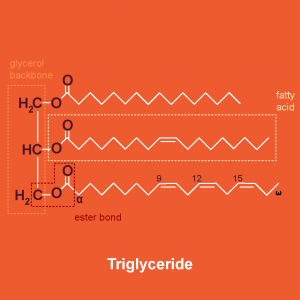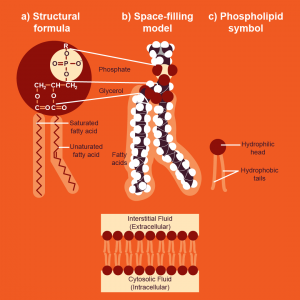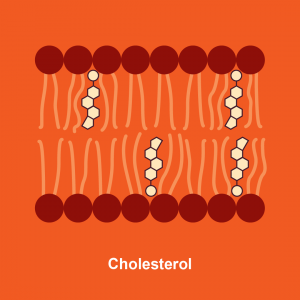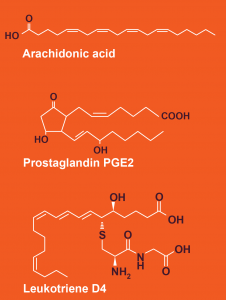Lipids
The last class of biological molecules are the lipids. Lipids are not considered biological polymers because the diverse structures of lipids do not contain a single identifiable monomer. In other words, there is no single building block that appears to be a part of all types of lipids. However, all lipids consist of carbon, hydrogen, and a very small proportion of oxygen. Due to the numerous nonpolar covalent bonds that comprise lipids, lipids are generally considered hydrophobic.
Many cellular lipids contain molecules known as fatty acids: extended hydrocarbon chains with a carboxyl group (-COOH) at one end. The hydrocarbon chains of fatty acids are nonpolar and hydrophobic. Fatty acids that contain only single carbon-carbon (C-C) bonds are called saturated fatty acids because all carbons form the maximum number of bonds to hydrogen. Saturated fatty acids tend to have a straight 3-D shape. Fatty acids that contain at least one double C-C bond are called unsaturated fatty acids. The double bonds in unsaturated fatty acids cause the hydrocarbon chain to bond or “kink”.
Triglycerides
Triglycerides (also known as triacylglycerols or simply “fats”) consist of a three-carbon molecule called glycerol covalently bound to three fatty acids. The covalent bond formed between the carboxyl groups of the fatty acids and the glycerol molecule is called an ester bond.
Triglycerides can be broken down in cells to release energy that the cell can harness for other cellular functions. As a result, one function of triglycerides is to store energy. Triglycerides store more energy per mass than carbohydrates (e.g. glycogen). Triglycerides are also stored in the cells of adipose tissue and function to insulate the human body from heat loss and protect the internal organs from injury.
Triglycerides are also consumed by humans. Saturated fats are triglycerides that contain saturated fatty acids. Saturated fats are generally solid at room temperature (e.g. butter). Unsaturated fats are triglycerides that contain at least one unsaturated fatty acid and are generally liquid at room temperature (e.g. olive oil). Because all fats contain large amounts of energy, the recommended daily intake of all fats is relatively small in proportion to carbohydrates and proteins.

Phospholipids
Phospholipids consist of a glycerol molecule covalently bound to two fatty acid molecules. The third carbon of glycerol is bound to a negatively charged phosphate group. The phosphate group may be covalently bound to an additional polar or charged chemical group. The charged and polar portion of phospholipids is hydrophilic and often referred to as the “head” of the molecule. The nonpolar and hydrophobic fatty acids are referred to as the “tails”. Molecules like phospholipids with a hydrophilic portion and hydrophobic portion are called amphipathic.
Phospholipids spontaneously assemble into special structures due to their amphipathic nature. One biologically important structure is the phospholipid bilayer. The hydrophilic heads of the lipids interact well with the surrounding aqueous solution, but the fatty acid tails interact best with one another. Therefore, phospholipids in aqueous solution may spontaneously form two layers. In each layer, the hydrophilic heads face outward toward the solution and the hydrophobic tails face inward, toward one another. Phospholipid bilayers serve as a scaffold for biological membranes, which you will learn about in lecture.

Steroids
Steroids, unlike triglycerides and phospholipids, consist of four fused carbon rings and other chemical groups. In humans, cholesterol serves many important cellular roles. Cholesterol consists of four carbon rings, plus a polar hydroxyl group (-OH) covalently bound to one ring and a short hydrocarbon chain covalently bound to another ring. As a result of the single hydroxyl group, cholesterol is weakly amphipathic. The steroid hormones, including the sex hormones testosterone and estrogen that determine the secondary sexual characteristics of humans, are made from cholesterol as a precursor. Cells also synthesize vitamins such as vitamin D from cholesterol precursors. Cholesterol is found in cell membranes: the polar hydroxyl group interacts with the hydrophilic phosphate heads of phospholipids. The nonpolar carbon rings and hydrocarbon chain interacts with the hydrophobic fatty acid tails of the phospholipids. You will discuss how cholesterol regulates membrane fluidity in lecture.

Eicosanoids and leukotrienes
Eicosanoids are lipids that consist of 20-carbons with structures that resemble fatty acids . Eicosanoids are important signaling molecules within and between cells. Leukotrienes are a type of eicosanoid that specifically functions as part of an immune response to tissue damage called inflammation. Eicosanoids and leukotrienes serve as signals that help white blood cells detect, respond, and repair tissue damage that results from infection or invasion. You will discuss the functions of these molecules later in lecture and, perhaps, in future courses.

There are many other types of lipids but, from the small subset covered by this course, you can see that lipids serve many cellular functions. Lipids form important structural components of cell membranes, store energy, insulate and protect the body, serve as hormones, and help immune cells send and receive signals during tissue damage.
Together, the four classes of biological molecules make up all the organic molecules in cells. Throughout Biology 1190, you will see examples of how the structures of these molecules specializes them for their unique and vital cellular functions. The understanding of basic chemical principles that shape molecules and the interactions between molecules is a critical part of your understanding of cellular and, therefore, human body function.
Summary:
- There are four classes of biological molecules:
- Carbohydrates are polar and hydrophilic chains of monosaccharides
- Monosaccharides such as glucose are the main cellular fuel
- Disaccharides sweeten foods and beverages
- Polysaccharides store energy in plant and animal cells and form part of the rigid plant cell wall
- Proteins are diverse molecules that perform many functions for the cell
- Proteins are chains of amino acids
- Protein structure can be organized into four hierarchical levels
- The structure of proteins determines their function
- Conditions that denature proteins also eliminate protein function
- Nucleic acids encode genetic information in cells
- Nucleic acids are polymers of nucleotides
- Genes are short sequences of DNA
- Genes are transcribed to mRNA and mRNA is translated to proteins
- The structure of DNA is related to how it is replicated and transcribed
- Lipids are diverse molecules that are not considered biological polymers
- Triglycerides store energy, insulate, and protect the body from injury
- Phospholipids are a structural component of biological membranes
- Cholesterol is a weakly amphipathic component of biological membranes
- Eicosanoids and leukotrienes are important signalling molecules between and within cells of the immune system
- Carbohydrates are polar and hydrophilic chains of monosaccharides
“leuko” = leukocyte or white blood cell; “triene” = characteristic three double bonds

